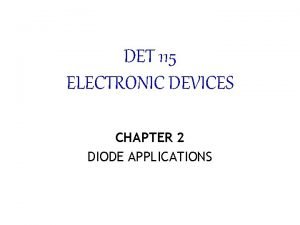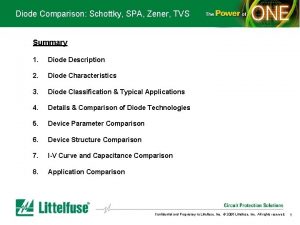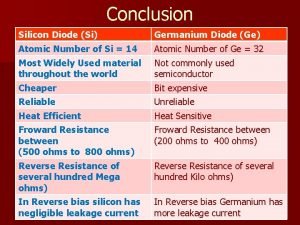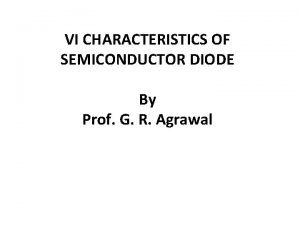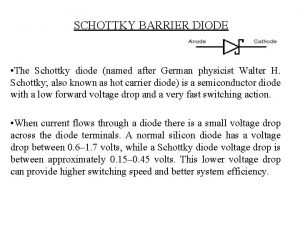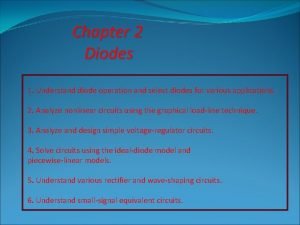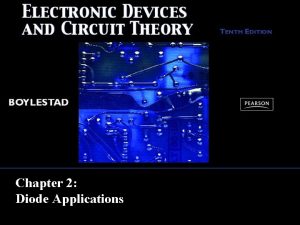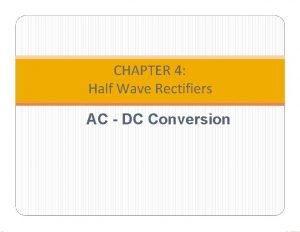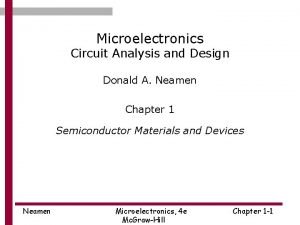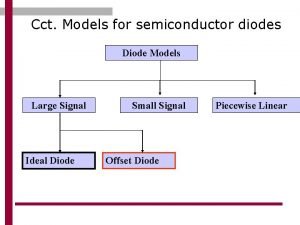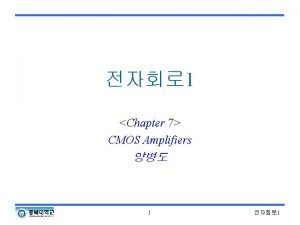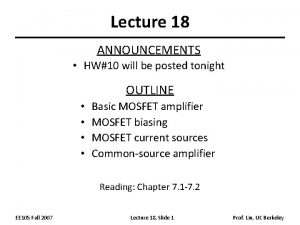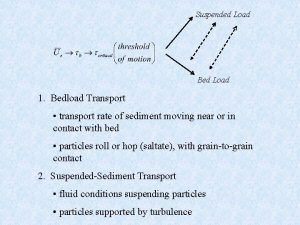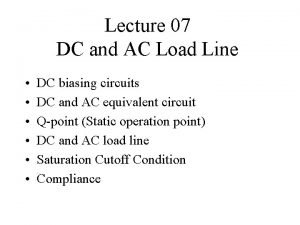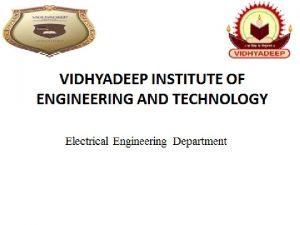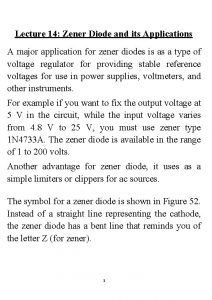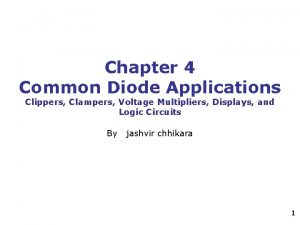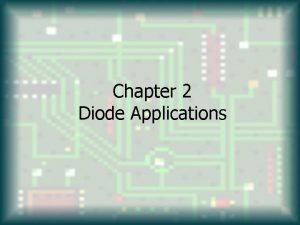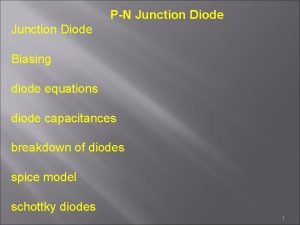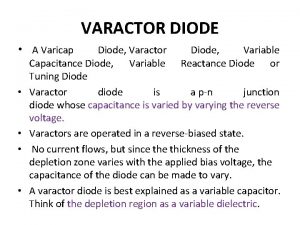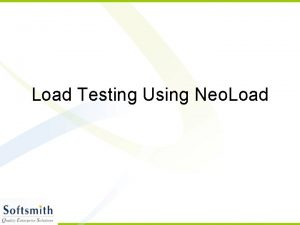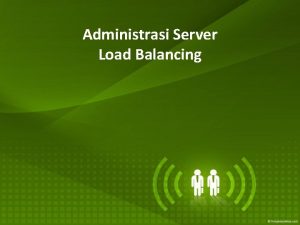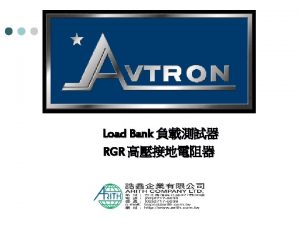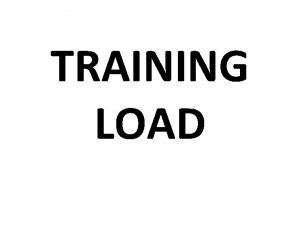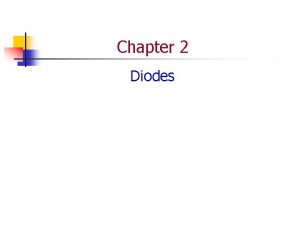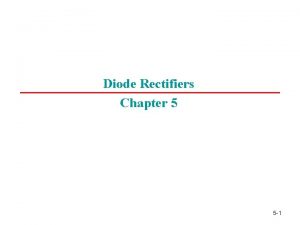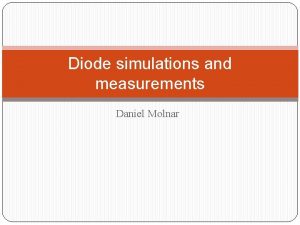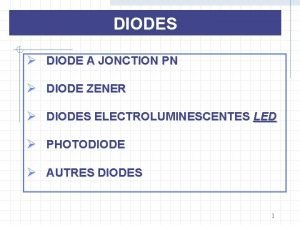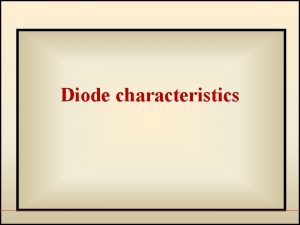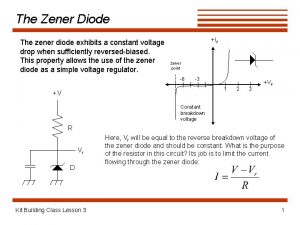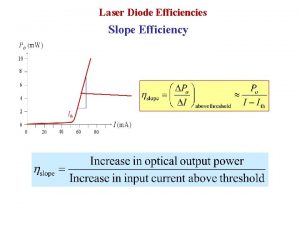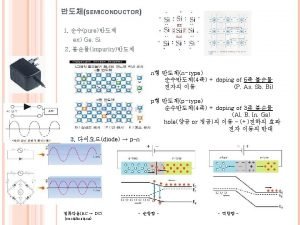Chapter 2 Diode Applications LoadLine The applied load































































- Slides: 63

Chapter 2: Diode Applications

Load-Line The applied load to the circuit will normally have an important impact on the point or region of operation of a device. Electronic Devices and Circuit Theory, 10/e Robert L. Boylestad and Louis Nashelsky Copyright © 2009 by Pearson Education, Inc. Upper Saddle River, New Jersey 07458 • All rights reserved.

Load-Line Analysis The load line (the applied load) plots all possible combinations of diode current (ID) and voltage (VD) for a given circuit. The maximum ID equals E/R, and the maximum VD equals E. The point where the load line and the characteristic curve intersect is the Q-point, which identifies ID and VD for a particular diode in a given circuit. Quiescent point (abbreviated “Qpt. ”) to reflect its “still, unmoving” Electronic Devices and Circuit Theory, 10/e Robert L. Boylestad and Louis Nashelsky 3 Copyright © 2009 by Pearson Education, Inc. Upper Saddle River, New Jersey 07458 • All rights reserved.

Series Diode Configurations Forward Bias Constants • Silicon Diode: VD = 0. 7 V • Germanium Diode: VD = 0. 3 V Analysis (for silicon) • VD = 0. 7 V • VR = E – VD • ID = I R = I T = V R / R Electronic Devices and Circuit Theory, 10/e Robert L. Boylestad and Louis Nashelsky 4 Copyright © 2009 by Pearson Education, Inc. Upper Saddle River, New Jersey 07458 • All rights reserved.

Series Diode Configurations Reverse Bias Diodes ideally behave as open circuits Analysis • VD = E • VR = 0 V • ID = 0 A Electronic Devices and Circuit Theory, 10/e Robert L. Boylestad and Louis Nashelsky 5 Copyright © 2009 by Pearson Education, Inc. Upper Saddle River, New Jersey 07458 • All rights reserved.

EXAMPLE For the series diode determine (a) VDQ and IDQ. (b) VR. Electronic Devices and Circuit Theory, 10/e Robert L. Boylestad and Louis Nashelsky Copyright © 2009 by Pearson Education, Inc. Upper Saddle River, New Jersey 07458 • All rights reserved.

Electronic Devices and Circuit Theory, 10/e Robert L. Boylestad and Louis Nashelsky Copyright © 2009 by Pearson Education, Inc. Upper Saddle River, New Jersey 07458 • All rights reserved.

EXAMPLE For the series diode configuration, determine VD, VR, and ID. Electronic Devices and Circuit Theory, 10/e Robert L. Boylestad and Louis Nashelsky Copyright © 2009 by Pearson Education, Inc. Upper Saddle River, New Jersey 07458 • All rights reserved.

• Since the applied voltage establishes a current in the clockwise direction to match the arrow of the symbol and the diode is in the “on” state, VD = 0. 7 V Electronic Devices and Circuit Theory, 10/e Robert L. Boylestad and Louis Nashelsky Copyright © 2009 by Pearson Education, Inc. Upper Saddle River, New Jersey 07458 • All rights reserved.

EXAMPLE • Determine Vo and ID for the series circuit Electronic Devices and Circuit Theory, 10/e Robert L. Boylestad and Louis Nashelsky Copyright © 2009 by Pearson Education, Inc. Upper Saddle River, New Jersey 07458 • All rights reserved.

Electronic Devices and Circuit Theory, 10/e Robert L. Boylestad and Louis Nashelsky Copyright © 2009 by Pearson Education, Inc. Upper Saddle River, New Jersey 07458 • All rights reserved.

Parallel Configurations Electronic Devices and Circuit Theory, 10/e Robert L. Boylestad and Louis Nashelsky 12 Copyright © 2009 by Pearson Education, Inc. Upper Saddle River, New Jersey 07458 • All rights reserved.

Example Determine the current I for the network: Electronic Devices and Circuit Theory, 10/e Robert L. Boylestad and Louis Nashelsky Copyright © 2009 by Pearson Education, Inc. Upper Saddle River, New Jersey 07458 • All rights reserved.

Electronic Devices and Circuit Theory, 10/e Robert L. Boylestad and Louis Nashelsky Copyright © 2009 by Pearson Education, Inc. Upper Saddle River, New Jersey 07458 • All rights reserved.

Example: Determine the voltage Vo for the network Electronic Devices and Circuit Theory, 10/e Robert L. Boylestad and Louis Nashelsky Copyright © 2009 by Pearson Education, Inc. Upper Saddle River, New Jersey 07458 • All rights reserved.

Half-Wave Rectification The diode only conducts when it is forward biased, therefore only half of the AC cycle passes through the diode to the output. The DC output voltage is 0. 318 Vm, where Vm = the peak AC voltage. Electronic Devices and Circuit Theory, 10/e Robert L. Boylestad and Louis Nashelsky 16 Copyright © 2009 by Pearson Education, Inc. Upper Saddle River, New Jersey 07458 • All rights reserved.

PIV (PRV) Because the diode is only forward biased for one-half of the AC cycle, it is also reverse biased for one-half cycle. It is important that the reverse breakdown voltage rating of the diode be high enough to withstand the peak, reverse-biasing AC voltage without entering the zener region. • • • PIV (or PRV) > Vm PIV = Peak inverse voltage PRV = Peak reverse voltage Vm = Peak AC voltage Electronic Devices and Circuit Theory, 10/e Robert L. Boylestad and Louis Nashelsky 17 Copyright © 2009 by Pearson Education, Inc. Upper Saddle River, New Jersey 07458 • All rights reserved.

Full-Wave Rectification The rectification process can be improved by using a full-wave rectifier circuit. Full-wave rectification produces a greater DC output: • • Half-wave: Vdc = 0. 318 Vm Full-wave: Vdc = 0. 636 Vm Electronic Devices and Circuit Theory, 10/e Robert L. Boylestad and Louis Nashelsky 18 Copyright © 2009 by Pearson Education, Inc. Upper Saddle River, New Jersey 07458 • All rights reserved.

Full-Wave Rectification Bridge Rectifier • • Four diodes are connected in a bridge configuration VDC = 0. 636 Vm Electronic Devices and Circuit Theory, 10/e Robert L. Boylestad and Louis Nashelsky 19 Copyright © 2009 by Pearson Education, Inc. Upper Saddle River, New Jersey 07458 • All rights reserved.

Full-Wave Rectification Center-Tapped Transformer Rectifier Requires • Two diodes • Center-tapped transformer VDC = 0. 636 Vm Electronic Devices and Circuit Theory, 10/e Robert L. Boylestad and Louis Nashelsky 20 Copyright © 2009 by Pearson Education, Inc. Upper Saddle River, New Jersey 07458 • All rights reserved.

Summary of Rectifier Circuits Rectifier Ideal VDC Half Wave Rectifier VDC = 0. 318 Vm Bridge Rectifier VDC = 0. 636 Vm Center-Tapped Transformer Rectifier VDC = 0. 636 Vm Realistic VDC Vm = peak of the AC voltage. In the center tapped transformer rectifier circuit, the peak AC voltage is the transformer secondary voltage to the tap. Electronic Devices and Circuit Theory, 10/e Robert L. Boylestad and Louis Nashelsky 21 Copyright © 2009 by Pearson Education, Inc. Upper Saddle River, New Jersey 07458 • All rights reserved.

EXAMPLE Determine the output waveform for the following network and calculate the output dc level and the required PIV of each diode. Electronic Devices and Circuit Theory, 10/e Robert L. Boylestad and Louis Nashelsky Copyright © 2009 by Pearson Education, Inc. Upper Saddle River, New Jersey 07458 • All rights reserved.

For the positive region of the input voltage Electronic Devices and Circuit Theory, 10/e Robert L. Boylestad and Louis Nashelsky Copyright © 2009 by Pearson Education, Inc. Upper Saddle River, New Jersey 07458 • All rights reserved.

For the negative part of the input the roles of the diodes will be interchanged and vo will appear as Electronic Devices and Circuit Theory, 10/e Robert L. Boylestad and Louis Nashelsky Copyright © 2009 by Pearson Education, Inc. Upper Saddle River, New Jersey 07458 • All rights reserved.

AND/OR GATES Positive logic OR gate. Electronic Devices and Circuit Theory, 10/e Robert L. Boylestad and Louis Nashelsky Copyright © 2009 by Pearson Education, Inc. Upper Saddle River, New Jersey 07458 • All rights reserved.

Electronic Devices and Circuit Theory, 10/e Robert L. Boylestad and Louis Nashelsky Copyright © 2009 by Pearson Education, Inc. Upper Saddle River, New Jersey 07458 • All rights reserved.

AND/OR GATES positive logic AND gate Electronic Devices and Circuit Theory, 10/e Robert L. Boylestad and Louis Nashelsky Copyright © 2009 by Pearson Education, Inc. Upper Saddle River, New Jersey 07458 • All rights reserved.

PIV For The Bridge Configuration The required PIV of each diode at the peak of the positive region of the input signal. For the indicated loop the maximum voltage across R is Vm and the PIV rating is defined by PIV Vm full-wave bridge rectifier Electronic Devices and Circuit Theory, 10/e Robert L. Boylestad and Louis Nashelsky Copyright © 2009 by Pearson Education, Inc. Upper Saddle River, New Jersey 07458 • All rights reserved.

PIV For Center-tapped Transformer Electronic Devices and Circuit Theory, 10/e Robert L. Boylestad and Louis Nashelsky Copyright © 2009 by Pearson Education, Inc. Upper Saddle River, New Jersey 07458 • All rights reserved.

Diode Clippers Clipper is a variety of diode networks that have the ability to “clip” off a portion of the input signal without distorting the remaining part of the alternating waveform. Electronic Devices and Circuit Theory, 10/e Robert L. Boylestad and Louis Nashelsky 30 Copyright © 2009 by Pearson Education, Inc. Upper Saddle River, New Jersey 07458 • All rights reserved.

Series Clippers • The diode in a series clipper “clips” any voltage that does not forward bias it, such as half-wave rectifier series clippers Electronic Devices and Circuit Theory, 10/e Robert L. Boylestad and Louis Nashelsky Copyright © 2009 by Pearson Education, Inc. Upper Saddle River, New Jersey 07458 • All rights reserved.

Biased Clippers Adding a DC source in series with the clipping diode changes the effective forward bias of the diode. Electronic Devices and Circuit Theory, 10/e Robert L. Boylestad and Louis Nashelsky 32 Copyright © 2009 by Pearson Education, Inc. Upper Saddle River, New Jersey 07458 • All rights reserved.

Example Determine the output waveform for the network Electronic Devices and Circuit Theory, 10/e Robert L. Boylestad and Louis Nashelsky Copyright © 2009 by Pearson Education, Inc. Upper Saddle River, New Jersey 07458 • All rights reserved.

The network will appear as below, and vo=vi +5 V. Electronic Devices and Circuit Theory, 10/e Robert L. Boylestad and Louis Nashelsky Copyright © 2009 by Pearson Education, Inc. Upper Saddle River, New Jersey 07458 • All rights reserved.

Example Determine the output waveform for the network Electronic Devices and Circuit Theory, 10/e Robert L. Boylestad and Louis Nashelsky Copyright © 2009 by Pearson Education, Inc. Upper Saddle River, New Jersey 07458 • All rights reserved.

Electronic Devices and Circuit Theory, 10/e Robert L. Boylestad and Louis Nashelsky Copyright © 2009 by Pearson Education, Inc. Upper Saddle River, New Jersey 07458 • All rights reserved.

Parallel Clippers The diode (ideal) in a parallel clipper circuit “clips” any voltage that forward bias it. DC biasing can be added in series with the diode to change the clipping level. Electronic Devices and Circuit Theory, 10/e Robert L. Boylestad and Louis Nashelsky 37 Copyright © 2009 by Pearson Education, Inc. Upper Saddle River, New Jersey 07458 • All rights reserved.

Example Determine vo for the following network Electronic Devices and Circuit Theory, 10/e Robert L. Boylestad and Louis Nashelsky Copyright © 2009 by Pearson Education, Inc. Upper Saddle River, New Jersey 07458 • All rights reserved.

Electronic Devices and Circuit Theory, 10/e Robert L. Boylestad and Louis Nashelsky Copyright © 2009 by Pearson Education, Inc. Upper Saddle River, New Jersey 07458 • All rights reserved.

Summary of Clipper Circuits more… Electronic Devices and Circuit Theory, 10/e Robert L. Boylestad and Louis Nashelsky 40 Copyright © 2009 by Pearson Education, Inc. Upper Saddle River, New Jersey 07458 • All rights reserved.

Summary of Clipper Circuits Electronic Devices and Circuit Theory, 10/e Robert L. Boylestad and Louis Nashelsky 41 Copyright © 2009 by Pearson Education, Inc. Upper Saddle River, New Jersey 07458 • All rights reserved.

Clampers A diode and capacitor can be combined to “clamp” an AC signal to a specific DC level. Electronic Devices and Circuit Theory, 10/e Robert L. Boylestad and Louis Nashelsky 42 Copyright © 2009 by Pearson Education, Inc. Upper Saddle River, New Jersey 07458 • All rights reserved.

Biased Clamper Circuits The input signal can be any type of waveform such as sine, square, and triangle waves. The DC source lets you adjust the DC camping level. Electronic Devices and Circuit Theory, 10/e Robert L. Boylestad and Louis Nashelsky 43 Copyright © 2009 by Pearson Education, Inc. Upper Saddle River, New Jersey 07458 • All rights reserved.

In general, the following steps may be helpful when analyzing clamping networks: 1. Start the analysis of clamping networks by considering that part of the input signal that will forward bias the diode. 2. During the period that the diode is in the “on” state, assume that the capacitor will charge up instantaneously to a voltage level determined by the network. 3. Assume that during the period when the diode is in the “off” state the capacitor will hold on to its established voltage level. 4. Throughout the analysis maintain a continual awareness of the location and reference polarity for Vo to ensure that the proper levels for Vo are obtained. 5. Keep in mind the general rule that the total swing of the total output must match the swing of the input signal. Electronic Devices and Circuit Theory, 10/e Robert L. Boylestad and Louis Nashelsky Copyright © 2009 by Pearson Education, Inc. Upper Saddle River, New Jersey 07458 • All rights reserved.

Example Determine vo for the following network for the input indicated. Electronic Devices and Circuit Theory, 10/e Robert L. Boylestad and Louis Nashelsky Copyright © 2009 by Pearson Education, Inc. Upper Saddle River, New Jersey 07458 • All rights reserved.

• The analysis will begin with the period t 1 → t 2 of the input signal since the diode is in its short-circuit state as recommended by comment 1. • For this interval the output is across R, but it is also directly across the 5 -V battery the result is Vo 5 V for this interval. • Applying Kirchhoff’s voltage law around the input loop will result in • The capacitor will therefore charge up to 25 V, as stated in comment 2. Electronic Devices and Circuit Theory, 10/e Robert L. Boylestad and Louis Nashelsky Copyright © 2009 by Pearson Education, Inc. Upper Saddle River, New Jersey 07458 • All rights reserved.

• The open-circuit equivalent for the diode will remove the 5 -V battery from having any effect on Vo, and applying Kirchhoff’s voltage law around the outside loop of the network will result in Electronic Devices and Circuit Theory, 10/e Robert L. Boylestad and Louis Nashelsky Copyright © 2009 by Pearson Education, Inc. Upper Saddle River, New Jersey 07458 • All rights reserved.

Electronic Devices and Circuit Theory, 10/e Robert L. Boylestad and Louis Nashelsky Copyright © 2009 by Pearson Education, Inc. Upper Saddle River, New Jersey 07458 • All rights reserved.

Summary of Clamper Circuits Electronic Devices and Circuit Theory, 10/e Robert L. Boylestad and Louis Nashelsky 49 Copyright © 2009 by Pearson Education, Inc. Upper Saddle River, New Jersey 07458 • All rights reserved.

Zener Diodes The Zener is a diode operated in reverse bias at the Zener Voltage (Vz). • When Vi VZ – The Zener is on – Voltage across the Zener is VZ – Zener current: IZ = IR – IRL – The Zener Power: PZ = VZIZ • When Vi < VZ – The Zener is off – The Zener acts as an open circuit Electronic Devices and Circuit Theory, 10/e Robert L. Boylestad and Louis Nashelsky 50 Copyright © 2009 by Pearson Education, Inc. Upper Saddle River, New Jersey 07458 • All rights reserved.

V i and R 1. Determine the state of the Zener diode by removing it from the network and calculating the voltage across the resulting open circuit. 2. Substitute the appropriate equivalent circuit and solve for the desired unknowns. Electronic Devices and Circuit Theory, 10/e Robert L. Boylestad and Louis Nashelsky Copyright © 2009 by Pearson Education, Inc. Upper Saddle River, New Jersey 07458 • All rights reserved.

Example For the following Zener diode network, determine VL, VR, IZ, and PZ. Electronic Devices and Circuit Theory, 10/e Robert L. Boylestad and Louis Nashelsky Copyright © 2009 by Pearson Education, Inc. Upper Saddle River, New Jersey 07458 • All rights reserved.

Following the suggested procedure: Since V L is less than VZ , the diode is in the “off” state. Substituting the open-circuit equivalent will result in; Electronic Devices and Circuit Theory, 10/e Robert L. Boylestad and Louis Nashelsky Copyright © 2009 by Pearson Education, Inc. Upper Saddle River, New Jersey 07458 • All rights reserved.

Fixed Vi, Variable RL • To determine the minimum load resistance that will turn the Zener diode on, simply calculate the value of RL that will result in a load voltage VL =VZ. That is, • Solving for RL, we have • Once the diode is in the “on” state, the voltage across R remains fixed at Electronic Devices and Circuit Theory, 10/e Robert L. Boylestad and Louis Nashelsky Copyright © 2009 by Pearson Education, Inc. Upper Saddle River, New Jersey 07458 • All rights reserved.

• and IR remains fixed at • The Zener current Electronic Devices and Circuit Theory, 10/e Robert L. Boylestad and Louis Nashelsky Copyright © 2009 by Pearson Education, Inc. Upper Saddle River, New Jersey 07458 • All rights reserved.

EXAMPLE • (a) For the following network , determine the range of RL and IL that will result in VRL being maintained at 10 V. • (b) Determine the maximum wattage rating of the diode. Electronic Devices and Circuit Theory, 10/e Robert L. Boylestad and Louis Nashelsky Copyright © 2009 by Pearson Education, Inc. Upper Saddle River, New Jersey 07458 • All rights reserved.

• (a) To determine the value of RL that will turn the Zener diode on The voltage across the resistor R Electronic Devices and Circuit Theory, 10/e Robert L. Boylestad and Louis Nashelsky Copyright © 2009 by Pearson Education, Inc. Upper Saddle River, New Jersey 07458 • All rights reserved.

• For fixed values of RL, the voltage Vi must be sufficiently large to turn the Zener diode on. The minimum turn-on voltage Vi Vimin is determined by Electronic Devices and Circuit Theory, 10/e Robert L. Boylestad and Louis Nashelsky Copyright © 2009 by Pearson Education, Inc. Upper Saddle River, New Jersey 07458 • All rights reserved.

Voltage-Multiplier Circuits Voltage multiplier circuits use a combination of diodes and capacitors to step up the output voltage of rectifier circuits. • • • Voltage Doubler Voltage Tripler Voltage Quadrupler Electronic Devices and Circuit Theory, 10/e Robert L. Boylestad and Louis Nashelsky 59 Copyright © 2009 by Pearson Education, Inc. Upper Saddle River, New Jersey 07458 • All rights reserved.

Voltage Doubler This half-wave voltage doubler’s output can be calculated by: Vout = VC 2 = 2 Vm where Vm = peak secondary voltage of the transformer Electronic Devices and Circuit Theory, 10/e Robert L. Boylestad and Louis Nashelsky 60 Copyright © 2009 by Pearson Education, Inc. Upper Saddle River, New Jersey 07458 • All rights reserved.

Voltage Doubler • Positive Half-Cycle o D 1 conducts o D 2 is switched off o Capacitor C 1 charges to Vm • Negative Half-Cycle o D 1 is switched off o D 2 conducts o Capacitor C 2 charges to 2 Vm Vout = VC 2 = 2 Vm Electronic Devices and Circuit Theory, 10/e Robert L. Boylestad and Louis Nashelsky 61 Copyright © 2009 by Pearson Education, Inc. Upper Saddle River, New Jersey 07458 • All rights reserved.

Voltage Tripler and Quadrupler Electronic Devices and Circuit Theory, 10/e Robert L. Boylestad and Louis Nashelsky 62 Copyright © 2009 by Pearson Education, Inc. Upper Saddle River, New Jersey 07458 • All rights reserved.

Practical Applications • Rectifier Circuits – Conversions of AC to DC for DC operated circuits – Battery Charging Circuits • Simple Diode Circuits – Protective Circuits against overcurrent – Polarity Reversal • Zener Circuits – Overvoltage Protection – Setting Reference Voltages Electronic Devices and Circuit Theory, 10/e Robert L. Boylestad and Louis Nashelsky 63 Copyright © 2009 by Pearson Education, Inc. Upper Saddle River, New Jersey 07458 • All rights reserved.
 Chapter 2: diode applications solutions
Chapter 2: diode applications solutions Tvs diode vs schottky
Tvs diode vs schottky Diode i-v characteristics
Diode i-v characteristics Tunnel diode v-i characteristics
Tunnel diode v-i characteristics Why schottky diode is called hot carrier diode
Why schottky diode is called hot carrier diode Piecewise linear diode model
Piecewise linear diode model Boylestad
Boylestad Formula of vrms in half wave rectifier
Formula of vrms in half wave rectifier Microelectronic circuit analysis and design
Microelectronic circuit analysis and design Diode offset model
Diode offset model 7/13
7/13 Pmos diode
Pmos diode Thrust load bearing
Thrust load bearing Tributary load and load path
Tributary load and load path Suspended load definition
Suspended load definition The point of intersection of dc and ac load line is called
The point of intersection of dc and ac load line is called Application of varactor diode
Application of varactor diode Gunn diode applications
Gunn diode applications Zener diode application
Zener diode application Applications of clampers
Applications of clampers Basic diode applications
Basic diode applications Hình ảnh bộ gõ cơ thể búng tay
Hình ảnh bộ gõ cơ thể búng tay Lp html
Lp html Bổ thể
Bổ thể Tỉ lệ cơ thể trẻ em
Tỉ lệ cơ thể trẻ em Gấu đi như thế nào
Gấu đi như thế nào Chụp phim tư thế worms-breton
Chụp phim tư thế worms-breton Chúa yêu trần thế
Chúa yêu trần thế Kể tên các môn thể thao
Kể tên các môn thể thao Thế nào là hệ số cao nhất
Thế nào là hệ số cao nhất Các châu lục và đại dương trên thế giới
Các châu lục và đại dương trên thế giới Công thức tính độ biến thiên đông lượng
Công thức tính độ biến thiên đông lượng Trời xanh đây là của chúng ta thể thơ
Trời xanh đây là của chúng ta thể thơ Mật thư tọa độ 5x5
Mật thư tọa độ 5x5 Làm thế nào để 102-1=99
Làm thế nào để 102-1=99 độ dài liên kết
độ dài liên kết Các châu lục và đại dương trên thế giới
Các châu lục và đại dương trên thế giới Thơ thất ngôn tứ tuyệt đường luật
Thơ thất ngôn tứ tuyệt đường luật Quá trình desamine hóa có thể tạo ra
Quá trình desamine hóa có thể tạo ra Một số thể thơ truyền thống
Một số thể thơ truyền thống Cái miệng nó xinh thế
Cái miệng nó xinh thế Vẽ hình chiếu vuông góc của vật thể sau
Vẽ hình chiếu vuông góc của vật thể sau Nguyên nhân của sự mỏi cơ sinh 8
Nguyên nhân của sự mỏi cơ sinh 8 đặc điểm cơ thể của người tối cổ
đặc điểm cơ thể của người tối cổ Thế nào là giọng cùng tên?
Thế nào là giọng cùng tên? Vẽ hình chiếu đứng bằng cạnh của vật thể
Vẽ hình chiếu đứng bằng cạnh của vật thể Phối cảnh
Phối cảnh Thẻ vin
Thẻ vin đại từ thay thế
đại từ thay thế điện thế nghỉ
điện thế nghỉ Tư thế ngồi viết
Tư thế ngồi viết Diễn thế sinh thái là
Diễn thế sinh thái là Các loại đột biến cấu trúc nhiễm sắc thể
Các loại đột biến cấu trúc nhiễm sắc thể Số nguyên là gì
Số nguyên là gì Tư thế ngồi viết
Tư thế ngồi viết Lời thề hippocrates
Lời thề hippocrates Thiếu nhi thế giới liên hoan
Thiếu nhi thế giới liên hoan ưu thế lai là gì
ưu thế lai là gì Hổ sinh sản vào mùa nào
Hổ sinh sản vào mùa nào Sự nuôi và dạy con của hươu
Sự nuôi và dạy con của hươu Hệ hô hấp
Hệ hô hấp Từ ngữ thể hiện lòng nhân hậu
Từ ngữ thể hiện lòng nhân hậu Thế nào là mạng điện lắp đặt kiểu nổi
Thế nào là mạng điện lắp đặt kiểu nổi Chapter 3 skills and applications
Chapter 3 skills and applications
